La Cabrera, Buenos Aires, Argentina
When I arrived in Buenos Aires, "Ojo de Bife" ("eye of beef") was at the top of most steak menus, giving the blessed ribeye its appropriate place in the steak pantheon. It reminded me of a Jeffrey Steingarten passage from his essay in Men's Vogue about a search across Spain for great steak--which has led me to order ribeye almost exclusively since reading it:
...the most delicious beefsteak is a thick (about two and a quarter inches) rib steak complete with its long rib bone and its spinalis dorsi , also known as the rib eye cap, the muscle that curves over the top of the eye, the most delicious muscle on the entire animal—tender, rich, juicy, brimming with beefy flavor and with umami...
Steingarten goes on to declare that
people who prefer any other muscle from the body of a steer—except for the laid-back greatness of a hanger steak—are confused and lacking in sensitivity, or have defective genes, and should not be permitted to talk about food.
Steingarten was in search of chuleta , the bone-in rib steak served across the Basque region of Spain, but his words about ribeye remain true in all steak-eating situations. Think of a bone-in lamb chop--tender, flavorful, marbled--and transpose it into a steak. And tell me you don't want that right now.
I had more than a couple ribeyes while in Buenos Aires, mostly because it's what people tell you to eat when you're there--and if not ribeye, then steak in some other form. After all, somebody has to eat the thousands of cows auctioned off every day .
Everyone I talked to from Buenos Aires responded similarly when I asked them to tell me "where the best steak in the city is." With a little bit of annoyance . I was the last in a long line of tourists asking this question, one which I think is distinctly American in its attitude. Where's the best steak? They were annoyed because the best steak is not an abstract idea in a vacuum; it is apart of a good meal somewhere which includes ambience, friends, wine, and many other things.
One more concrete reason for this attitude may be availability. In the U.S., you need to visit a steakhouse or well-connected butcher to have the best beef because that merchant will have relationships with the right people to source it. They have leverage and connections that a grocery store or chain restaurant just doesn't have. The high echelons of beef quality are not easy to reach, and when you go to a place like Peter Luger you're paying not just for their 1800 degree broiler and cooking expertise; you're paying for the fact that nobody can get steak as tasty as they can.
From what I understand, Argentina doesn't have this same separation. You can walk into an unassuming diner and be completely blown away. That's not to say that you should take for granted that a steak will be good everywhere--the restaurant still has to care enough to pay attention and buy good beef in the first place (and cook it well). But other aspects of the meal play a huge role.
Such was the case with La Cabrera , which I walked into late in the afternoon. Located in the Palermo section of Buenos Aires, which is quite chic with boutiques, bars, and a gritty tree-lined beauty, I asked to sit outside and enjoy a light breeze coming through. I glanced at the menu long enough to decide on an order of morcilla (blood sausage) to start, the ribeye, and a side of potatoes. When the waiter came by and heard my order, though, he started shaking his head.
"No, it's too much," he said. He quickly axed the order of potatoes, then sent for a half-order of ribeye, which I'd asked for rare. "I may look skinny, but I can eat," my mind was trying to translate via a feeble knowledge of high school Spanish. But he had already moved on to wine, so I ordered a glass of Malbec and gave in.
Moments later a basket of bread arrived with three condiments: a red and green pepper based pair of sauces, and a half head of rich, well-roasted garlic. I'd seen this garlic trick often in Argentina, and began tentatively munching on bread, afraid of the meal that awaited me. The waiter poured me a giant glass of wine and nodded.
Within a few minutes my morcilla arrived, hot and crisp on the outside. Next to it was a chimichurri sauce and something red, creamy and spicy. I was beginning to understand why the man had halved my ribeye order.
Blood sausage is something I've grown to love living in Estonia, where it's quite popular around Christmastime. The sound of it probably doesn't appeal, but it's actually quite delicious. Unlike in the UK where they fill "black pudding" with grain, in Argentina, morcilla is stuffed with ground meat, aggressive spicing, and pristine chunks of fat, then filled with blood and poached. The flavor is not at all iron-like as you might imagine if you've ever bitten your lip really hard--nor is it organ-y or offal-like. It's merely a rich meatiness that's really unlike anything else I've taste. Most people who get over the idea of blood sausage love it.
Most blood sausages are poached gently after stuffing, which congeals the blood, then roasted or seared to crisp them up. The play of textures between the inside and outside is very appealing, and the flavor is wonderful. These were the largest morcilla I'd ever seen. And there were two of them.
I was about halfway through my second sausage when the half-ribeye arrived. Except it hardly looked like a half portion; it was the same size as the full orders I'd seen elsewhere. Just as I was starting to wonder where I'd put all this food, a second waiter arrived with armfuls--literally armfuls--of trays. Which were not headed to other tables. They were headed for mine. Suddenly before me were 13 ramekins of food that would accompany my steak. I pushed the last half of morcilla away and sat back to ponder my next move.
I cut first into the steak, which was, quite frankly, transcendent. It was perfectly cooked, juicy, beefy, tender. I feel like the same words are always used to describe steak, but what more can I say? The texture was perfect, with a mouthwatering caramelization on the outside and softness on the inside. But most of all was the profoundly beefy flavor, which came out especially with a sprinkle of salt. (Though the next time I go to Argentina I'm going to be very pretentious and bring my own salt, because the stuff they have is always very fine-grained and out of shakers. This steak--and many others I enjoyed--was crying out for some Maldon or Fleur de Sel. End rant.)
And the accompanying sides? I couldn't even tell you what was good. I just ate what was closest to me. In front of the steak was a dish of lentils with olives and two potato preparations with a creamy sauce and possibly chives.
Behind it was a polenta-like mash of chickpeas, hard-boiled quail eggs with string beans, and some very garlicky young potatoes.
On the pedestal was a polenta-like creamed corn, (then, counter-clockwise) mashed potatoes with mustard seeds, stewed wild mushrooms, a very sweet confit of garlic cloves (center), stewed raisins with pears that had cloves and a brandy sweetness, onions and peppers that were tomato-ey and vinegary, and a wonderful dish of zucchini in a buttery, almost cream-of-wheat-like substance.
Phew. I concentrated on the steak, punctuating its richness with sharper flavors, softening things with the potatoes and polenta, then leading my tongue into sweeter territory before pulling it back to the savory main course. My palate was doing somersaults. It had no idea what to do with itself. Mostly it was singing.
As the Malbec set in, swirling my brain, I sat back to catch up with myself. Surveying the table, I congratulated myself for finishing the steak. But I'd hardly made a dent in most of the accompaniments. This seemed to be quite normal, though, as the waiter whisked it away and I asked for la cuenta . Before the check arrived, a free glass of sparkling white wine was presented. This made the total all the more unbelievable, when it was placed on the table: the equivalent of $27. You can't get a meal this good for that much anywhere.
La Cabrera
Cabrera 5099
Palermo Viejo,C14BG
Buenos Aires, Argentina


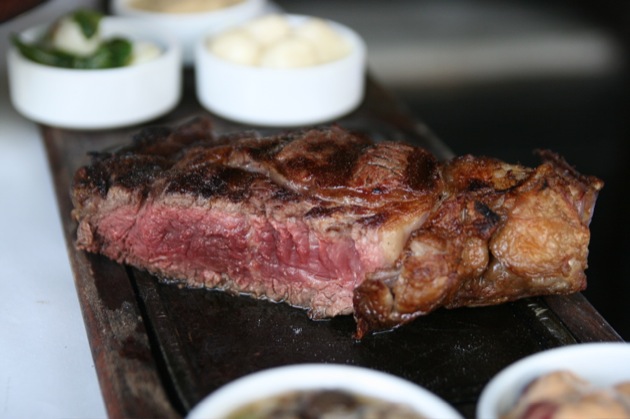
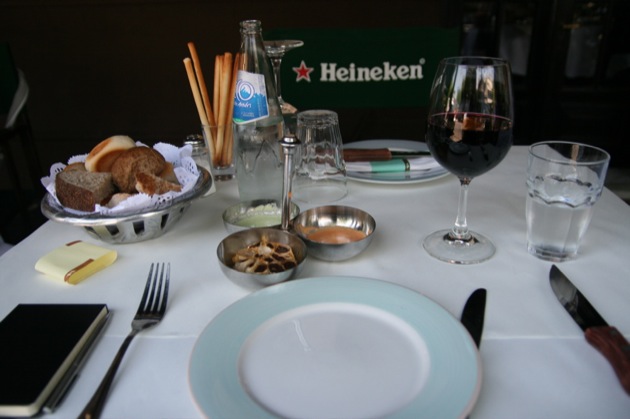
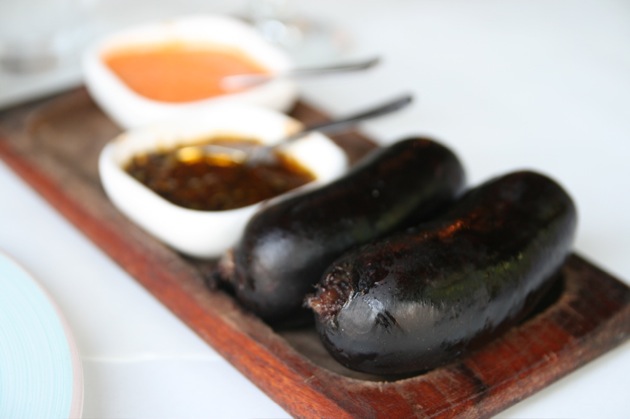
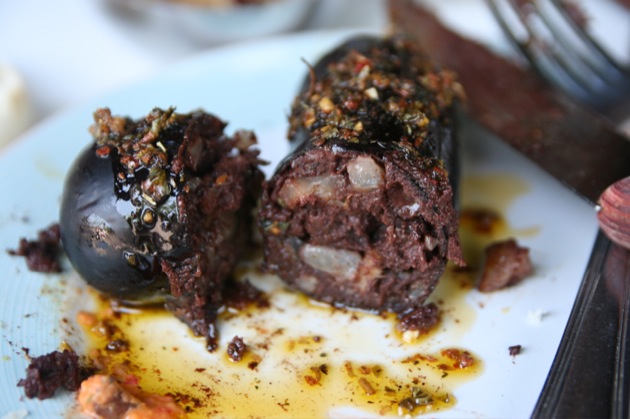
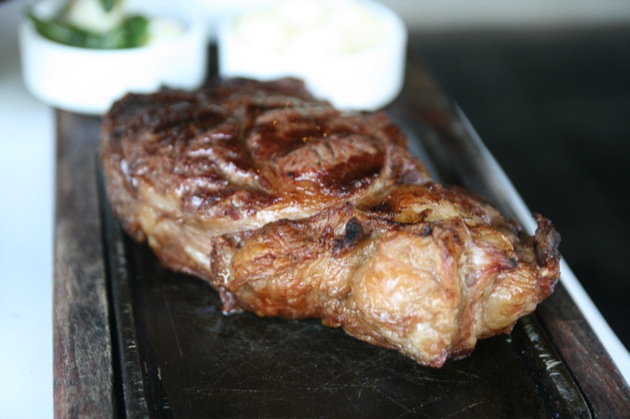
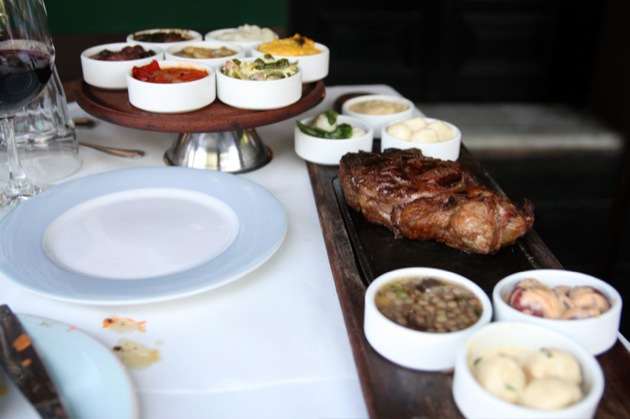
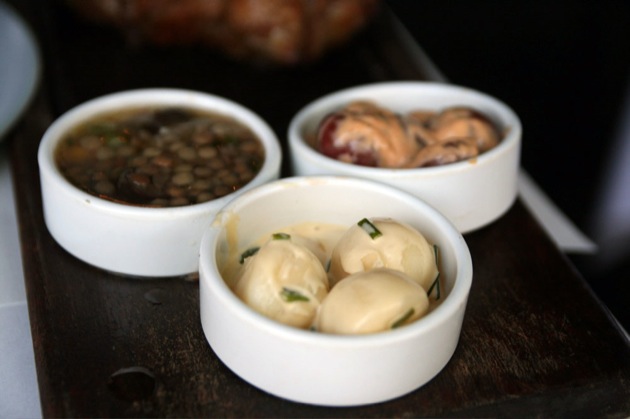
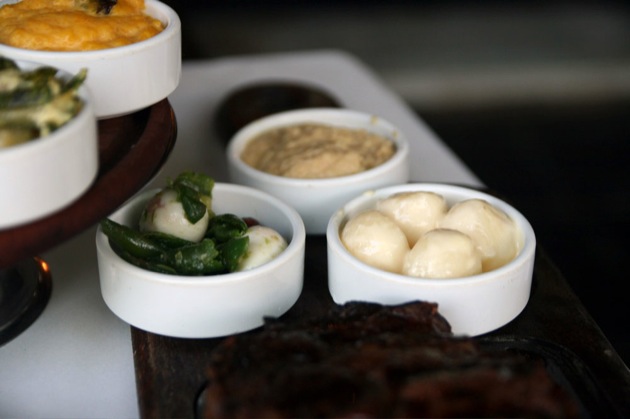
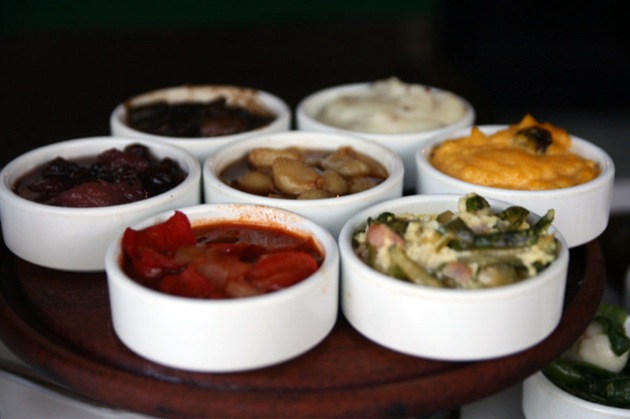
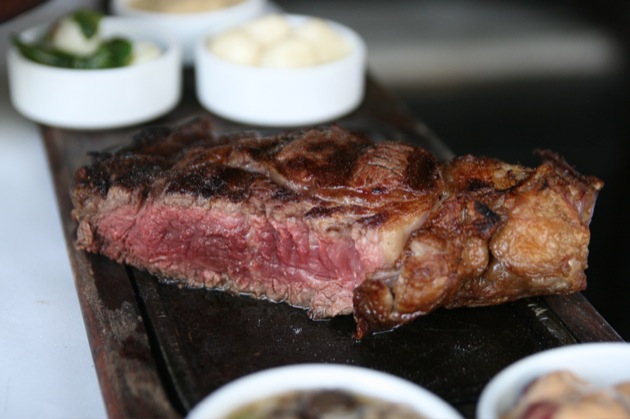
Comments:
Blog Comments powered by Disqus.